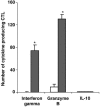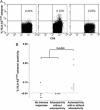Autoreactive CD8 T cells associated with beta cell destruction in type 1 diabetes
- PMID: 16339897
- PMCID: PMC1317949
- DOI: 10.1073/pnas.0508621102
Autoreactive CD8 T cells associated with beta cell destruction in type 1 diabetes
Abstract
Type 1 diabetes is a T cell-mediated autoimmune disease, and insulin is an important target of the autoimmune response associated with beta cell destruction. The mechanism of destruction is still unknown. Here, we provide evidence for CD8 T cell autoreactivity associated with recurrent autoimmunity and loss of beta cell function in type 1 diabetic islet transplant recipients. We first identified an insulin B chain peptide (insB10-18) with extraordinary binding affinity to HLA-A2(*0201) that is expressed by the majority of type 1 diabetes patients. We next demonstrated that this peptide is naturally processed by both constitutive and immuno proteasomes and translocated to the endoplasmic reticulum by the peptide transporter TAP1 to allow binding to HLA-A2 in the endoplasmic reticulum and cell surface presentation. Peripheral blood mononuclear cells from a healthy donor were primed in vitro with this peptide, and CD8 T cells were isolated that specifically recognize target cells expressing the insulin B chain peptide. HLA-A2(insB10-18) tetramer staining revealed a strong association between detection of autoreactive CD8 T cells and recurrent autoimmunity after islet transplantation and graft failure in type 1 diabetic patients. We demonstrate that CD8 T cell autoreactivity is associated with beta cell destruction in type 1 diabetes in humans.
Figures



References
-
- Roep, B. O. (2003) Diabetologia 46, 305–321. - PubMed
-
- Roep, B. O., Arden, S. D., De Vries, R. R. & Hutton, J. C. (1990) Nature 345, 632–634. - PubMed
-
- Serreze, D. V., Leiter, E. H., Christianson, G. J., Greiner, D. & Roopenian, D. C. (1994) Diabetes 43, 505–509. - PubMed
-
- Wicker, L. S., Leiter, E. H., Todd, J. A., Renjilian, R. J., Peterson, E., Fischer, P. A., Podolin, P. L., Zijlstra, M., Jaenisch, R. & Peterson, L. B. (1994) Diabetes 43, 500–504. - PubMed
Publication types
MeSH terms
Substances
LinkOut - more resources
Full Text Sources
Other Literature Sources
Medical
Research Materials

